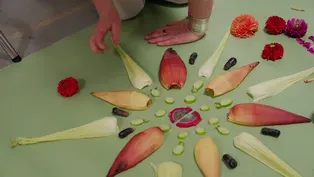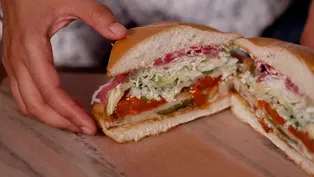Oregon Art Beat
Gena Renaud
Clip: Season 25 Episode 2 | 9m 29sVideo has Closed Captions
Gena Renaud creates Japanese confections called wagashi.
Gena Renaud creates Japanese confections called wagashi. She's one of the country's only wagashi experts. The treats have been presented as part of a traditional tea ceremony for hundreds of years.
Problems with Closed Captions? Closed Captioning Feedback
Problems with Closed Captions? Closed Captioning Feedback
Oregon Art Beat is a local public television program presented by OPB
Oregon Art Beat
Gena Renaud
Clip: Season 25 Episode 2 | 9m 29sVideo has Closed Captions
Gena Renaud creates Japanese confections called wagashi. She's one of the country's only wagashi experts. The treats have been presented as part of a traditional tea ceremony for hundreds of years.
Problems with Closed Captions? Closed Captioning Feedback
How to Watch Oregon Art Beat
Oregon Art Beat is available to stream on pbs.org and the free PBS App, available on iPhone, Apple TV, Android TV, Android smartphones, Amazon Fire TV, Amazon Fire Tablet, Roku, Samsung Smart TV, and Vizio.
Providing Support for PBS.org
Learn Moreabout PBS online sponsorship(birds chirping) (bright music) - Oh, they're just beautiful.
They're perfect.
The ones that I'm looking for, this variety here is a multiple-petaled variety and I love it also because it's this deep pink, which will get deeper pink when it gets pickled and brined.
What you're looking for are these fluffy, full petals.
(bright music continues) (birds chirping) So I think what I'm gonna do is toss them in here and just flip it around a little bit to try to get some of the little brown stems.
It's just simply sea salt and plum wine vinegar.
And so just like as you're doing pickles, this will be in the refrigerator for about two days and you go to it each day and just kind of squeeze it.
You'll find more liquid comes out.
(gentle music) My name is Gena Renaud and I make wagashi.
Wagashi literally translates to Japanese sweets.
The wa stands for Japanese and gashi is sweets.
All of it, it all really comes down to nature.
Nature is the muse.
(gentle music continues) In Japan, back in the old days, they didn't have air conditioning and so a lot of the sweets they would make would be visually cooling and refreshing.
Pools of water, you know, fish splashing about.
Oftentimes the wagashi maker will give the sweet a name.
(gentle music continues) And we're gonna make jelly.
So one of the really important things about wagashi is that it really needs to appeal to all five senses.
Just want all those petals to separate.
How is the cherry blossom gonna hold its place?
So this is what we're gonna do.
We're gonna suspend it.
So these are the kind of problem-solving things I learned at Michael Curry.
When you're working on puppets and sets, there's just, like, constant problem-solving.
(bright music) Working there, it was really kind of wonderful to be with people who were makers, physically crafting with their hands.
I had spent 25 years doing graphic and industrial design, eventually working at Nike and for adidas.
So this was in "The New York Times" magazine.
They never told me that it was going to be, like, spread out on a big table with cats roaming around.
(chuckles) (dramatic music) - Top five video countdown number five, for all of its homegrown spirit, my friend Gena and her delightful little wagashi.
- [Gena] That felt amazing.
I felt like I was getting invited into some club.
- It is homemade and it is excellent.
Oh, I broke a tooth.
No, I'm just kidding.
- I fell under Gena's spell a couple years ago.
She walked into a tea shop with a tray of wagashi.
I did a double take like one of those cartoon characters where the springs come boing out of your eyes.
I am obsessed with the manju.
So think buttery dough rolled out wrapped around an intensity of bean paste jam.
13 hours in the making, I might add.
The tops are glazed with a little bit of dark soy and white wine, which gives this toasty aroma.
- The manju is filled with sweet lima bean paste.
Totally familiar, you know, especially to people in the South.
So when I tell them that they're eating sweet lima beans, they're like, "What?"
So it's a little bit more familiar to the Western palate.
So I think what I'm gonna do is go for a white camellia and we're going to add a little bit of pink blush.
And what I want is a cool pink.
A lot of effort goes into determining what colors you're doing.
(bright music) - They may be small, but each one contains an entire philosophy.
You taste the joy, the commitment, the rigor.
This is not like popping a batch of brownies in the oven.
(bright music continues) - Did you play with Play-Doh when you were young?
I sure did.
(chuckles) There.
That's a nice shape.
(bright music) Here are the tools that I use.
Branding irons and molds.
(bright music continues) These molds started my journey into wagashi making.
I stumbled on them in a Japanese grocery store in Portland.
I then started researching more and more.
I finally found some Japanese cookbooks with confection recipes.
My mother translated them for me.
I was turning 50 in the next year, my son was starting high school, and my relationship/marriage of 27 years was coming to an end.
I felt like I needed to kind of go back and figure out what made me me, and part of that was my history.
It was a time where I really had to reflect on what the next step was for me in my life, and that I wanted to create something that would make both me and my son proud.
(bright music) In 2010, I launched Yume Confections.
Yume means dream.
'Cause it was kind of a dream.
And my friends kept saying, "But, you know, people are gonna call it yummy."
And I said, "I think that's okay too."
Portland was a great place to introduce wagashi because the food cultures is just so, you know, open to everything and anything.
- [Karen] Gena just embodies that mythical Portland food scene.
Everything made in small batches, plunging down the rabbit hole to perfect that thing you love even if it makes no sense on a spreadsheet.
(gentle music) - If you did a blind tasting for sweets, tea sweets, I think she'd be up there in the upper echelon.
(gentle music continues) - Confections have been an important part of Japanese tea ceremonies for hundreds of years.
(customer speaks in foreign language) The sweet wets your palate in a sense to get ready to take the tea.
And it's also a reminder, the metaphor of, you know, the balance of sweet and the bitter, you know, in life, as in the tea ceremony.
(gentle music continues) So wagashi can be as simple as everyday snacks in the afternoon with your tea.
(customers speak indistinctly) (bright music) I'm creating something that is very intimate that somebody's going to touch and put into their mouth and take into their body.
Ichigo ichie, ichigo ichie, yeah.
That is the philosophy or the idea that it's a one-in-a-lifetime chance meeting, that this moment is here, it's now, and it will never happen again.
The person who's going to taste this, maybe this is going to be their first experience.
Then I want it to be really good.
I want them to be really delighted.
(chuckles) I love the ephemeral nature of my work.
(bright music continues) It's dreamy.
It's yume.
(bright music continues) (no audio)
Video has Closed Captions
Isabella Cassini is a photographer who photographs different foods crashing together. (8m 57s)
Video has Closed Captions
Megan Sanchez draws on her Mexican and Egyptian heritage at her Portland restaurant Güero. (6m 52s)
Providing Support for PBS.org
Learn Moreabout PBS online sponsorshipOregon Art Beat is a local public television program presented by OPB













